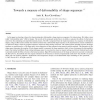Free Online Productivity Tools
i2Speak
i2Symbol
i2OCR
iTex2Img
iWeb2Print
iWeb2Shot
i2Type
iPdf2Split
iPdf2Merge
i2Bopomofo
i2Arabic
i2Style
i2Image
i2PDF
iLatex2Rtf
Sci2ools
107
Voted
PRL
2007
2007
Towards a measure of deformability of shape sequences
In this paper we develop a theory for characterizing how deformable a shape is given a sequence of its observations. We define a term called ‘‘deformability index’’ (DI) for shapes. The novelty of the proposed method lies in its ability to separate the effects of observation noise from the underlying non-rigid deformation process. The DI is computed from the tracked positions of a sequence of deformable shapes, using an affine camera model. Our method assumes that a deformable shape sequence can be represented by a linear combination of rigid basis shapes, where the weights assigned to each basis shape change with time. The tracked points obtained from the 2D shape sequence are transformed to a 3D shape space, whose dimension is then estimated using spectral analysis methods. The dimension of this shape space determines the number of basis shapes needed to represent the shape sequence, which, in turn, determines the deformability index. Our method is different from existing...
Related Content
| Added | 27 Dec 2010 |
| Updated | 27 Dec 2010 |
| Type | Journal |
| Year | 2007 |
| Where | PRL |
| Authors | Amit K. Roy Chowdhury |
Comments (0)

